
Zimmer Biomet: Reshaping Healthcare Training with AR and VR
- August 9, 2023
Listen and Subscribe on Your Favorite Platform:
Episode Summary
This week’s episode of XR Industry Leaders offers an insider’s view on how extended reality is changing healthcare, straight from Zimmer Biomet. Thomas Kopec, Senior Manager of Digital Learning, discusses his company’s pioneering use of AR and VR for surgical planning, medical training, and more.
Listeners will learn how Zimmer Biomet uses HoloLens and VR headsets to enable real-time CT visualizations during surgery. Kopec also explains the virtual collaboration tools that facilitate remote mentorship and live Q&A during procedures. Gain valuable insight into how VR is enhancing pre-operative planning, with surgeons able to immerse themselves in realistic experiences prior to entering the OR.
Kopec candidly shares results from initial VR pilot programs, including challenges like hardware costs, managing headsets, and user adoption. Looking ahead, he predicts VR and AR will play an integral role in healthcare through training, collaboration, rehearsal, and competency evaluation.
For those interested in how extended reality will shape medicine going forward, this is a must-listen episode. Kopec provides an insider’s perspective on VR’s transformative potential for surgery, training, and beyond. Tune in for cutting-edge use cases and an exciting glimpse into the future of healthcare.
Key Moments
What Zimmer Biomet is doing with AR (08:01)
Zimmer Biomet’s perspective on the timeline for AR (10:48)
How Zimmer Biomet is thinking about, and using, AR (15:31)
Feedback (19:59)
Pain points from pilot stage to scale (26:03)
Future of VR and AR (30:37)
About the Guest
Tommy Kopec began working as Senior Manager for Digital Medical Education at Zimmer Biomet in July 2022, overseeing extended realities (VR, MR), as well as the online education for HCPs. Previously, Tommy was a tenured Associate Professor of Kinesiology at a university in Birmingham, AL. He also completed his PhD in Human Performance in 2016 from The University of Alabama. Before returning to school for his terminal degree, Tommy worked as a Certified Athletic Trainer at University of South Alabama with their Football and Baseball programs, as well as an outreach athletic trainer with Encore Physical Therapy, covering all athletics at Baker High School in Mobile, AL.
About Zimmer Biomet
Zimmer Biomet has been based in Warsaw since it was founded in 1927. Today, Zimmer Biomet has operations in more than 25 countries around the world and sells products in more than 100 countries.
Zimmer Bioment’s global team designs, manufactures and markets effective, innovative solutions that support orthopedic surgeons and clinicians in restoring mobility, alleviating pain and improving the quality of life for patients around the world. Our musculoskeletal technologies and a wide range of related products and services make us valuable partners to healthcare providers in more than 100 countries.
We’re building on a strong history of success to enhance the value we provide to healthcare providers and their patients. Zimmer Biomet maintains world-class scientific facilities and resources and collaborates with leading clinicians and researchers around the world.
Links and Resources
Learn more about getting started with XR in our ultimate guide to managing VR training for work.
Episode Transcript
Brad Scoggin: Hey there, welcome to “XR Industry Leaders” with ArborXR. My name is Brad Scoggin, and I am the CEO and one of three co-founders of ArborXR. And we’ve had the opportunity of working with thousands of companies since 2016, and we’ve learned a ton about what it takes for XR to be successful in your organization.
Will Stackable: And I’m Will Stackable, co-founder and CMO. This podcast is all about interviewing the leaders who are on the ground making XR happen today. True pioneers in the space from Amazon, Walmart, and UPS to Koch, Pfizer, and beyond to uncover the pitfalls, lessons learned, and secrets that you can use to help grow XR in your organization.
Brad Scoggin: All right, well today we get to sit down with Tommy Kopec. Tommy is the senior manager for digital medical education at Zimmer Biomet. Tommy, thanks so much for joining us today.
Tommy Kopec: Thanks for having me. I’m excited to be here.
Brad Scoggin: It was fun, we were just talking, Tommy’s calling in from Alabama today, and I’m originally from Oklahoma, so we were just talking about small town life in the Midwest. But maybe Tommy, just to kick us off, tell us a little bit, at a high level, what does Zimmer Biomet do?
Tommy Kopec: Sure. We are a medical device manufacturer, and so if you think of joint replacement parts, those hardwares, that’s what we do. We manufacture those, we install them, so we don’t install them, the healthcare providers install them, but so my job is to help get those medical education initiatives and trainings accelerated so our healthcare providers are prepared to do that in the operating room. So we manufacture the devices basically, and then we help the healthcare providers understand how to implement them and put them in the body.
Brad Scoggin: Got it. That’s very cool. So tell me too, we have a little background on you, and so before you’re at Zimmer, I know you worked as an instructor, and you organized a lot of onsite, some remote training. So maybe tell us a little bit about the challenges that you faced when you were doing the web-based training.
Tommy Kopec: Well, certainly everyone’s familiar with the most recent pandemic of COVID-19, so I was actually teaching in higher education when that happened, and so we, just like everyone else, were forced to go online and it was a great time to get up to speed on online training and education. I think I had a leg up maybe on some other professions because it wasn’t completely foreign, we had a lot of web-based, computer-based trainings before, but this was an opportunity to really expand that and see what else was going on out there. And so we utilized all kinds of new, or I did anyway, new implements for gamification of learning. That became a bigger component of my CV of outlook for how to improve training and education. And that’s something that we’ve continued here at Zimmer Biomet actually. One of the aspects that we do is, I’m sure we’ll get into MR and XR, but we also do our website for surgeon focused or healthcare provider focused learning. The LMS we use, the learning management system we use there, has a gamification built into it, so we have ways to track on a leaderboard, which is great. Healthier providers probably tend to be a little competitive, and so it’s neat to have these kinds of leaderboards that we can put up there and give people points and badges and all that for completing learning tasks.
Brad Scoggin: We’re all just a bunch of big kids. We grew up playing games. That’s very cool. And we talk a lot about COVID just being such an accelerant for technology adoption and forcing us into things that, it was really hard for a season, and then opened our eyes to maybe some more efficient ways of doing things. Maybe tell us a little bit about your transition into XR, just in general, and then how that led to your current role at Zimmer Biomet.
Tommy Kopec: Sure. Yeah, so again, I was teaching in higher education, tenure track and all that, and I’m happy to say I was awarded tenure and promoted.
Brad Scoggin: Oh wait, yeah, we forgot to say, you are a doctor, Tommy Kopec. That is true.
Tommy Kopec: I am a PhD. But yeah, so I was teaching, my background’s in athletic training, so sports medicine and the initial injury evaluation. So when you watch a football or basketball game, basketball’s going on now, someone gets hurt, the people that run out, they’re on the court and do the initial assessment, that’s my career, so that’s where I started in healthcare. And then I loved it, but I loved teaching, so being able to get hands-on and teach either younger students, or when I became old enough and was certified teaching people who are assigned to me as a preceptor, I just loved it. And so I pursued teaching, teaching, teaching, and did the PhD, was teaching athletic training and healthcare and kinesiology courses, and around the pandemic time and just started opening my eyes to all these other cool things that are out there. Besides just the way I was teaching, there’s other ways, and so learning about some of these other… The mixed reality world and learning about what’s AR versus MR versus VR and nailing that was exciting for me. Brad, you mentioned it, growing up playing video games. Yeah, I’m maybe not quite middle-aged, but throughout the nineties we played tons of video games, in the early 2000s, when I was in grade school, high school, even in college.
Will Stackable: This was pre Fortnite.
Tommy Kopec: It was pre Fortnite, so I may have only stuck to one game if I was…
Will Stackable: I’ve got to ask, what was your go-to? Do you have a go-to game? Brad and I are both Halo back in the day.
Brad Scoggin: Oh, and before that though, GoldenEye, before that.
Tommy Kopec: Oh, okay. So I was going to say GoldenEye or Perfect Dark, once we got the expansion pack.
Brad Scoggin: Oh yeah, Perfect Dark.
Tommy Kopec: For the Nintendo 64. Or wrestling. No Mercy was a big one.
Brad Scoggin: You could do the whole Royal Rumble, get all your buddies out. Yeah, that was fun.
Tommy Kopec: But we definitely did the land parties. I’d laugh, on the original Xbox, we had some tertiary friends from high school, but we all liked Halo, so it was like, okay, well, we’ll be real good friends on Friday or Saturday, come over. We’ll hard line. Don’t peek over our shoulders. Don’t look at our TV screen.
Brad Scoggin: The good old days.
Will Stackable: Xbox Connect. Oh, yeah.
Tommy Kopec: Yeah. It was cool. I mean, now [inaudible].
Brad Scoggin: I still have a gym bag full-
Tommy Kopec: I wish I had the time.
Brad Scoggin: With two Xboxes in my whole setup in storage that every once in a while I’m like, I want to pull it out for my kids. I don’t know if they… Anyways.
Tommy Kopec: I have the bass guitar and drums and a guitar for a rock band, for the Beatles rock band, that’s just sitting in a closet. I’m like…
Brad Scoggin: Good times.
Tommy Kopec: PlayStation 3 too. So I’m like, I don’t even know what I’m going to do with it, but I have a hard time getting rid of it. Finding out there are different ways to engage learners and that learning doesn’t stop formally at college, high school, whatever. There’s different ways. I started getting into instructional design and seeing learning development, and that led me to this job at Zimmer Biomet as, again, the senior manager for digital medical education, which is a really fancy way of saying that we’re trying to get our medical training and education endeavors up to, at this case, 2023, we want to make sure we’re offering online learning and then that it’s substantial and that it’s valid and worthy of someone sitting there and interacting with it.
Will Stackable: I love it. One of the things that interested me about Zimmer Biomet when we first started working with you guys is seeing, okay, this is a company that has operations in, I think more than 25 countries, sales in 100+ countries, and you’ve got multiple interesting use cases with AR and VR. So I’d love to hear just a little bit about what is Zimmer Biomet doing? Maybe you could start with AR, talk a little bit about that, and then we can transition to VR.
Tommy Kopec: We have a strategic partnership that we are using AR to help clinicians in the operating room so they’re able to… There’s a couple different use cases, really the best, the coolest way is we can get a CT scan and we can actually overlay that scan on top of the patient. So basically with these-
Brad Scoggin: Wow.
Tommy Kopec: Goggles, or glasses I guess, the headset allows you to look down at the patient, and obviously it’s much different than VR where it’s a pass through lens so you can see everything that’s going on, but we can overlay that anatomy on top of this individual’s hip and so as you insert tools-
Brad Scoggin: Wow.
Tommy Kopec: As you start making measurements, you get real time feedback. You can see for yourself, if there’s a particular defect, that’s readily apparent as you’re planning your next step in the surgery, so it’s really pretty cool. Another-
Brad Scoggin: That’s awesome.
Tommy Kopec: Use case would be, we have a proprietary interactive suite of an operating room, and so we are able to show off some of that technology and all the technologies we have in the operating room by putting on the headset. A little simpler way of utilizing this headset is being able just to have live audio and video in the OR. And so if we’re, one for training education, that’s one of our big focuses, you can cast this to a larger screen so people, just like residents maybe would anyway, get in the theater to watch, they can see the microphones are built in, just like with the VR headsets, microphones and speakers are built right in. So you can have a real dialogue or real question and answer forum while you’re there with a live case. So really pretty cool.
Will Stackable: And I know we saw that there’s a great news announcement that you guys are bringing the first FDA cleared mixed reality navigation system for hip replacement using mixed reality. It’s interesting that it’s just now we’re starting to see some of these products come on the market. What’s been your perspective on the timeline of how long it’s take… We’ve been talking about AR and VR for forever, really for 30 years or whatever, but it seems that just now we’re starting to see some of these real world applications that are being used in ORs and in other, for training and everything else around the world. But what’s been your personal feel just as you’ve entered this in the timeline and what it takes to get XR into the real world?
Tommy Kopec: Well, I think that there’s still the intimidation of… I’m laughing with you guys about playing video games and maybe putting on a headset or the whole VR concept isn’t that foreign, but out in the, I don’t know, in industry, it’s just been slower to adapt. They’re slower to manufacture as well. So as we go through our development cycles, I think some of the hesitation, it does take substantial resources and effort and time to get it right, because what you don’t want, if we think about gaming, and I just mentioned gamification, what we don’t want is that gamification feel. So you don’t want it to feel like a video game when you’re trying to prepare a surgeon or show somebody, “This is all of our tools.” We spend a lot of time with those CAD files getting them just right, and has all the disclaimers on the bottom of the tool, if you turn. They’re incredibly detailed. So you don’t want to undercut that by having a cartoon feel and so I think getting that feel is really important.
And so I think it’s probably a little bit of hesitation from a wider working audience, but you’ve had multiple guests on this show already from big companies who, again, are showing the reliability of it and how valid it is to accelerate learning. Most of them have been like onboarding. Ours is a little different, it is kind of onboarding, we’re onboarding the healthcare professionals to perform the surgery safely and effectively using our tools and using our product, and so there’s still an onboarding going on. It’s maybe a little different, but ultimately it’s the same goal. It’s trying to get someone from new to proficient as quickly as possible, and I think that’s where we’re really shining or where we are finding our sweet spot with VR.
Brad Scoggin: Well, no, change is always hard, and we talk the silver lining of COVID helping force some of this change. But FDA cleared is a big deal. There’s some ISVs we talk with that have gotten insurance approval to pay for some of their applications, and I think that is a big moment that a lot of people aren’t talking about, just for XR overall. When you start seeing that level of approval, you have insurance paying for things, that is a huge step of maturity, I think, that we should all be celebrating for where XR is at today.
Tommy Kopec: Absolutely, yeah, and that’s funny too to think about AR is this newer technology, big push with that, and we’re just now getting where VR is awesome and barely stable and incredible, and already you’re seeing AR spinning off and there’s a big push for that to, how can we use this? And helping people understand. I think part of my job and my team’s job is to help people understand the differences of VR, AR. Again, we kind of think of AR, the way we’re using it, at Zimmer Biomet, for, again, more clinical applications versus VRs, we use it for training and education purposes. With that said, there’s tons of exceptions and crossovers there, but it’s so neat to see VRs finally… People getting comfortable with it. The headsets are becoming more affordable as well.
Now there’s some really high tier models maybe that violate that, but they’re pretty accessible. Even when we take them to shows and show off some of the procedures we have, a number of people are like, “Well, how can I get this on my headset?” Because people already have headsets. Again, they’re really user-friendly and, again, the price point isn’t as dramatic as it used to be. So I think that we still have VR for a long time, but I’m excited about all technologies so AR coming on the scene and getting that rocket strapped to it, I’m all for it. We’re going to jump on board of that too. At Zimmer Biomet, we’re trying to be bold, we’re trying to be innovative, and so when we see these new technologies, we want to be on the front end of that.
Brad Scoggin: Definitely.
Will Stackable: You talked about AR and there’s some fantastic new headsets coming on the market even soon, Magic Leap’s coming out with theirs, it’s available, but starting to get better penetration now. Let’s switch over to VR. We can go to Best Buy and pick up a quest for a couple of hundred dollars. How is Zimmer Biomet thinking about and using VR right now?
Tommy Kopec: Yeah, well, again, it’s so easy now to get into VR. I want to encourage everyone, if anyone’s listening and hasn’t tried it out, go for it because the barrier to entry is so low, and that’s a great thing because we want more people using it and more people being comfortable with it and more people adopting it. So the way we generally use it is in this small little town in the middle of Indiana, Warsaw, Indiana, is where our manufacturing in a number of medical device companies, manufacturing plants are. If you look into Warsaw, the history of Warsaw, it’s funny how many orthopedic companies have spun off from this small little town, but-
Brad Scoggin: Interesting.
Tommy Kopec: You drive through, it’s still a small town, there’s no doubt about it, but it has such a cool history to it. Anyways, that’s where we have our headquarters, and so we have a fleet of headsets that stay there that we basically loan out as necessary. So generally our salespeople will contact us and say, “Hey, I have an event coming up. I want to show off blah, blah, blah procedure with blah, blah, blah surgeon,” so there’s a whole request form, and we overnight them a headset, or two or three or whatever they need. Actually, we obviously use the Arbor system to help manage that and that’s incredibly, it’s been a game changer for us. So being able to manage the fleet.
I’m over the Americas, but we’re a global company, and so we work with our partners in EMEA, APAC, Australia, New Zealand, and the rest of Latin America and Canada. So we have headsets everywhere. So being able to track them, see what software or firmware versions they are. We just developed another module just earlier today actually, or finished it passed all the routing that it needed to, so it’s as simple as a couple clicks, and now that module is live on everyone’s headset. It’s just incredible. So the salespeople request those headsets, we send them out, and they do the live demonstrations, or event demonstration right in front of the surgeon, or the group of surgeons. And it can be helpful for helping them understand any sticky points before a surgeon gets into the OR. It’s great for the reps themselves to freshen up on a procedure potentially. So that’s the everyday use that we have.
We do go to bigger trade shows and events as well, and we showcase it. And so we’ll have a TV that has a procedure on loop, gets people to look over at us, get their attention to come over. We try and get them in that headset and give them that immersive experience. That’s, again, the big difference for me between VR and AR is that immersive experience. With VR, you’re fully there, you’re fully immersed. AR, it just has a completely different use case. And so you don’t need that immersive, you need to pass through.
But so I think it’s important to get people the experience of, what does this feel like? And it’s incredible, it takes a couple of minutes to figure out, how to do your hands work to grab the tools? And all that. But then you start watching people and you’re like, “Oh, I can figure out what step they are on the procedure, the way they’re holding their hand or whatever hand motion they’re doing.” So even though they’re standing in the middle of the floor looking like a goof, you can be like, “Oh, okay, I know what step you’re on. Okay.”
Will Stackable: Yeah, the classic VR has a marketing problem that nobody looks good in a headset, but when you put on the headset, it’s amazing.
Tommy Kopec: It’s great. So many people are like, “Can you take a picture of me? You can take a video of me.” Like, “Yeah, absolutely. I’m happy to.”
Will Stackable: It’s not going to be the same.
Brad Scoggin: We started out years ago with VR arcades, and it was a funny thing we did not expect that, because it is such an isolating experience, that people would be embarrassed. They’d come in with their friends, but they would be embarrassed to put on the headset and have people watch them. So there are those funny little unexpected things.
Will Stackable: So it was big to be able to cast to a TV was actually really helpful because then the other people who aren’t in the headset can at least have a 2D representation of what you’re seeing. I’m curious, what kind of feedback have you been hearing, either from your sales reps or from people on the ground at the trade shows? Has it been helpful to have this tool?
Tommy Kopec: Without a doubt. So we had one of the industries bigger, or one of the biggest events that the industry has, AAOS, or the American Academy of Orthopedic Surgeons was in Las Vegas this year, but in March, and we had over 70 people over two and a half days come in, 70 unique cases of people coming and putting headsets on and trying out. A lot of those were actually on the younger side, so medical students, so maybe residents, but maybe even still in med school, and I think that that might be one of our target audiences because they’re the ones who are going to need more reps. So again, if you think of med school resident, they don’t get a whole lot of hands-on practice in a live case, and so you reduce the travel cost, the logistics of them going to a lab or a cadaver lab, you don’t have the necessity to, again, to have a specimen there, or if they use sawbones, there’s just no destruction. There’s no loss of resources. If you make a mistake, there’s a zero harm possibility. So you just restart the module and you just try again until you can nail the entire process.
And so I think that’s invaluable for us and so the salespeople have been loving it because every time they see it, every time we have a new module, a new procedure released, they’re like, “Oh my God,” [inaudible] they keep you, they’re like, “What else? What else? When are you going to have this one? When are you going to have this one?” But it’s so helpful for them to see it. And then when they show their surgeons, again, the surgeons are blown away and just saying, “Man, this is so impressive.” And again, you have that initial learning curve of like, “Oh, this is what my hands look like?” But then a minute or two later, they’re like, “Okay.” They’re grabbing the tool, they’re grabbing the leg, they’re putting this in, putting that in. And it’s so impressive to me how quickly people ramp up to that level of, again, I don’t know of proficiency, but it’s certainly comfort. You go from looking like, “Oh, I look like a robot,” to like, “Oh, now I’m smoothly moving and doing it.” So the salespeople have been loving it. Well, we are able to showcase it, absolutely work, people love it.
I’ll say, you mentioned, Will, about casting. So casting is still maybe the final frontier of VR stability. We still have issues with it. We’ve tried a couple different solutions and until a headset’s ready to go old school and just have a hard line from the headset to the TV, which I know is ugly and is antithetical to technology, but casting’s still a little bit of an issue, certainly for us. And so we instead we’ll have a TV that’s looped, again, a recording, like an MP4 or video file or whatever of our procedure, and so that helps satisfy that. You don’t have to be in VR to see it and appreciate it.
Brad Scoggin: You hit on something that I think is super important to us. You talk about, with the medical students or residents, the ability to get in and go through the procedure again and again without the waste, without the mess, and that’s just so important. When we think about VR specifically, I mean XR, but VR specifically, we think about it’s something that should give us our time back, train at your house, in your dorm, you don’t have to go in and mess with a cadaver. You’re not going through cadavers. There’s just a lot of value there, that hits home for us, when you think about the time savings that we can have to get back into real life.
Tommy Kopec: Absolutely. And that’s crucial as we think about medical students and residents who maybe have a little more time, but the more you advance in your career, you-
Brad Scoggin: Exactly.
Tommy Kopec: Or if we just talk about video games again, I don’t know the last time I played a video game.
Brad Scoggin: Exactly.
Tommy Kopec: Time just evaporates.
Brad Scoggin: What is a video game?
Tommy Kopec: Yeah. At this point, I don’t even know what’s out anymore. But the same idea for healthcare providers that time becomes so precious. So if we can accelerate learning, if we can accelerate that onboarding experience, then that’s where we’re going to see the biggest win. And I think we are seeing that. I think there’s published research out there about some of our procedures being utilized and people, there’s one particular study I have in mind, had people either just read the surgical technique guides for an hour or they got to practice in VR for an hour, and then both groups went and practiced on the saw bone, the model, and with obviously the VR group performed better, they had fewer mistakes, they had better accuracy with all the steps. It’s just such a great learning tool.
And so, Will, to hit back on something you asked about, maybe not quite barriers, but it’s the explosion of VR. I think the more we can demonstrate that, again, the ROI that we’re seeing some great effects from this, and we’re going to continue to push that and help people understand that using this virtual reality or augmented reality just accelerates your learning or your increase in knowledge.
Will Stackable: So I want to zoom in there a little bit. We’re hearing this over and over again from organizations large and small, that there’s massive ROI, not only time savings, but also your hip insight product is actually allowing for more accurate surgeries, which means out of 1000 surgeries, you’re going to have fewer errors. So if it’s this transformative, why aren’t we seeing this technology everywhere? And I guess the question is, what have you experienced and what are you seeing are some of the kind of pain points in getting the friction points from getting pilot stage to scale?
Tommy Kopec: Sure. We are a global brand, a global company, and so one of the bigger problems that we’ll encounter, which isn’t directly tied to VR, is localization of clearances procedures. So again, maybe something’s cleared in Mexico that’s not cleared in Columbia, versus Canada, versus… We cover region, EMEA, but England’s different than Northern Ireland, you know what I mean? Or Poland. So keeping all those regions lined up is difficult and so we certainly rely on our local colleagues there to help us understand what’s available and what’s not. Again, a great thing about the ArborXR system is that we’re able to individually unclick a procedure that’s not yet available in X country. So it’s really convenient for us, from that fleet management perspective, to be able to isolate what’s on each individual headset.
That’s our big problem with the application side. I don’t know other friction points or why everyone else isn’t using it. I do still think that there’s that intimidation of putting a headset on and I can tell you from people from within our company, there’s a hesitation of just trying to learn something very new. Doesn’t seem like there’s a lot of applicable lateral steps. So if you think of using a new spreadsheet, if you’re using Smartsheet for the first time, well, if you’ve learned Excel or you know you can get by with Excel, you can probably figure out Smartsheet. It does a lot more and it’s just such a great reason to use this new thing, but you have something to compare it to. I think that people have the idea that VR doesn’t have that comparison.
I think as we develop VR, we keep pushing for this technology, I think our job is to show them, you really do. If we do VR right, then you will see there won’t be this big friction. You’ll seamlessly fit in. It’ll start making sense. I mentioned that, that people who are clumsy with their hands at first, just takes a couple of minutes and you start figuring out, oh, this button controls this grip, but then if I push this button, it powers on the power drill or whatever tool they’re using in the OR. And one, it’s rewarding, so back to getting into teaching for the first time, it still sparks that kind of… When you see those aha moments, it’s still is powerful where you’re like, oh, they’re making that connection of this is how I’m using my hands in this immersive virtual environment. So I think we have to break down that barrier of intimidation.
We talked about cost. Again, when people want to purchase their own headsets, I’m like, “Man, you don’t have to buy them through us. Buy them from wherever. Get them on a Black Friday deal or whatever deal’s coming up.” Again, it is still a couple of hundred bucks, which maybe not everyone can swing, but compared to what it was a few years ago, I think that as more competition gets in the marketplace, that’s going to keep going down. And again, hopefully that friction will decrease. And I think that, for instance, one, your product, but then also this podcast, is helpful in that front to help people understand that from all these different backgrounds and careers and industries, there’s an application. And I think we’re all hitting on the same thing, just being able to… You mentioned saving time, just expediting and making more efficient use of our time. And I think from a medical training education standpoint, we at Zimmer Biomet have definitely felt that.
Brad Scoggin: I think you hit on something that it really is a collective effort for all of us to attack these little friction points to see this technology move forward, technology that we’re all excited about, those of us who are in it, that we’re seeing these incredible results. Tommy, you get a 10 out of 10 for hitting the Arbor plug script, so I thank you for that. Just kidding. But as you wrap-
Tommy Kopec: [inaudible].
Brad Scoggin: The Venmo. Yeah. So as we wrap here, I’d love to hear your take on, as an educator at heart, where do you see, so educator who’s in healthcare, where do you see the future of this going?
Tommy Kopec: Maybe this sounds too pie in the sky, but it’s almost limitless. Your imagination is what’s capping the utilization of this because we have, without getting too much into what we have in development, the way that we are developing VR right now is very OR focused and procedure focused, but the applications beyond that are extremely wide open and ready to be delved, and we have some projects down the pipeline that are going to explore that.
I think that VR has this unique ability, again, to get you immersive without you having to travel anywhere. I can sit here in my office in Birmingham, Alabama, and can be in a virtual operating room. I can be in a collaborative mode, so me and my partners and a surgeon and a resident can all be in four different places and all meet in that VR operating room and see all the steps that we need to do to complete this task. I just think it’s incredible. So from an educational standpoint, I think that, again, there’s no real… Maybe that’s too, I don’t know, Pollyanna, it’s limitless. We have all the ability, all that runway ahead of us for how we want to use it. If it’s collaborating, if it’s doing more intense maybe training or evaluation periods. We have a couple of internal dialogues about formalizing some of these VR procedures, and I think some of your other guests have shared that too, of having an assessment built into it.
Again, you’re at a low risk, immersive virtual environment. I think we need to really hit that nail on the head and understand the blessing that is. There is no risk. There’s no logistical nightmare to interact with. You just hit restart from a getting away from game over video game stuff. At the end of the day, you can just hit restart and try again and get as many reps as you can. So from an educational standpoint, I love that ability to make progress and immediately try again.
Brad Scoggin: No, I love that. The sky’s the limit for a low risk virtual environment, for what you can do. I think that’s just a beautiful picture. And especially from a company like Zimmer Biomet, who’s definitely a leader, you’ve already let out with an FDA cleared module, which is really cool. So Tommy, this has been great. We really appreciate your time. I know you’re too busy to play a video game, just like us, so your time is valuable. But thanks so much for sitting down with us today.
Tommy Kopec: Thank you guys so much. I appreciate you inviting me on here, and we were proud for Zimmer Biomet to be bold and innovative.
Will Stackable: Thanks, Tommy.
Tommy Kopec: Thank you guys.
Brad Scoggin: Well, that was a fun interview. The whole time, we got to talk about Halo, we got to talk about GoldenEye, Perfect Dark. And honestly, the whole time, I’m thinking, being from a small town Oklahoma, and it’s lunchtime, I’m thinking about a small town diner with some chicken fried steak. But that was great talking to Tommy. I think to me, the way we ended that, just encapsulated the whole, what’s exciting about what they’re doing is you’ve got somebody with the authority of an FDA cleared VR application who is dreaming limitless dreams about what could happen in a risk-free virtual immersive environment. And that to me, that’s very exciting.
Will Stackable: Yeah, it’s true. I love talking to companies like this, and Tommy was… It was a real treat. Just interesting that now we’re seeing big companies using both AR and VR, multiple use cases. For us, it was new to talk to somebody that’s using VR for sales, being at a conference, being able to demonstrate some of their technologies in a way they couldn’t before. And then on the other end, surgeons putting on mixed reality devices and being able to do hip replacements and knee replacements and other types of very complicated surgeries more effectively, more accurately. That’s like sci-fi, it’s wild. It’s real world, it’s happening right now.
Brad Scoggin: It is. Well, thank you all so much for listening. Make sure you listen or subscribe wherever you consume podcasts and we will catch you next time.
Will Stackable: Thanks.
Never Miss an Episode
Get notified in your email inbox when new episodes go live.
Share this Episode:

Never Miss an Episode
Get notified in your email inbox when new episodes go live.
Episodes
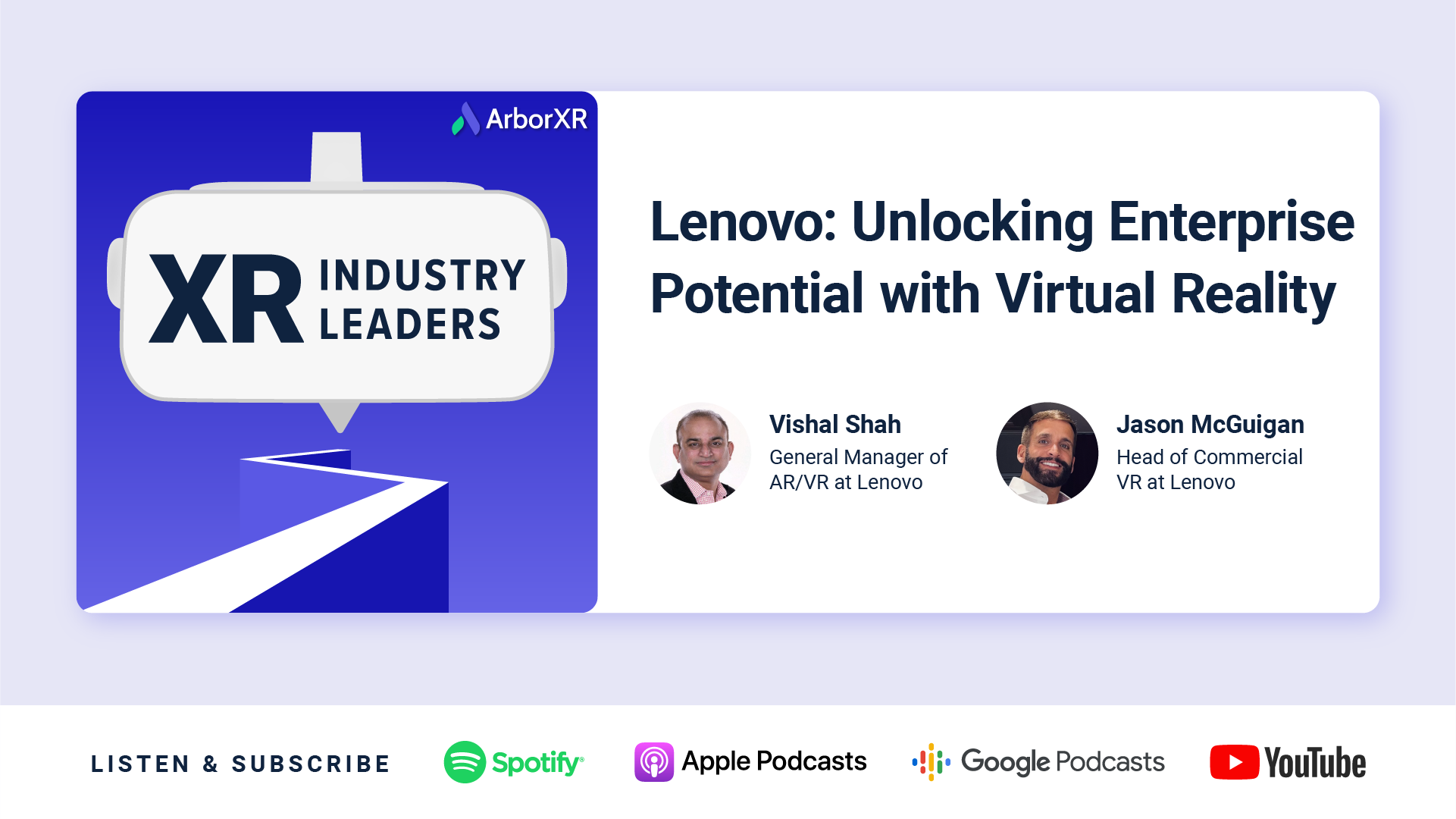
Lenovo: Unlocking Enterprise Potential with VR
Dive into the dynamic world of extended reality (XR) with Lenovo’s Vishal Shah and Jason McGuigan as they unravel Lenovo’s new enterprise XR solution: the Lenovo ThinkReality VRX.

PICO: Practical Enterprise Applications in XR at Scale
Explore XR’s future with PICO’s Amir Khorram in XR Industry Leaders. Insightful discussion on VR enterprise solutions, partnerships, and industry adoption.
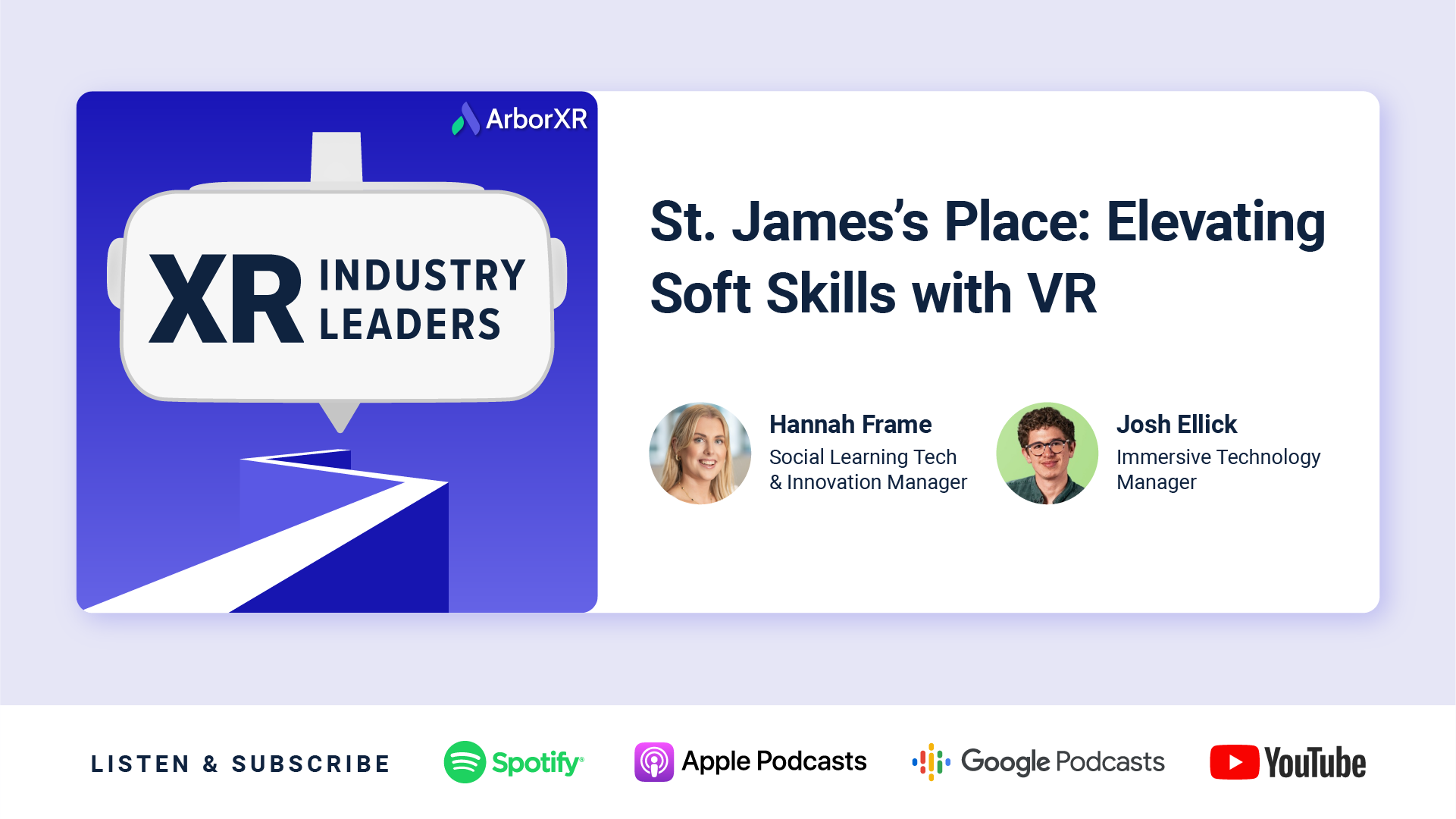
St. James’s Place: Elevating Soft Skills with VR
Hannah & Josh St. James’s Place discuss using VR to train advisor soft skills, challenges of managing headsets at scale, lessons on user adoption, and content development.
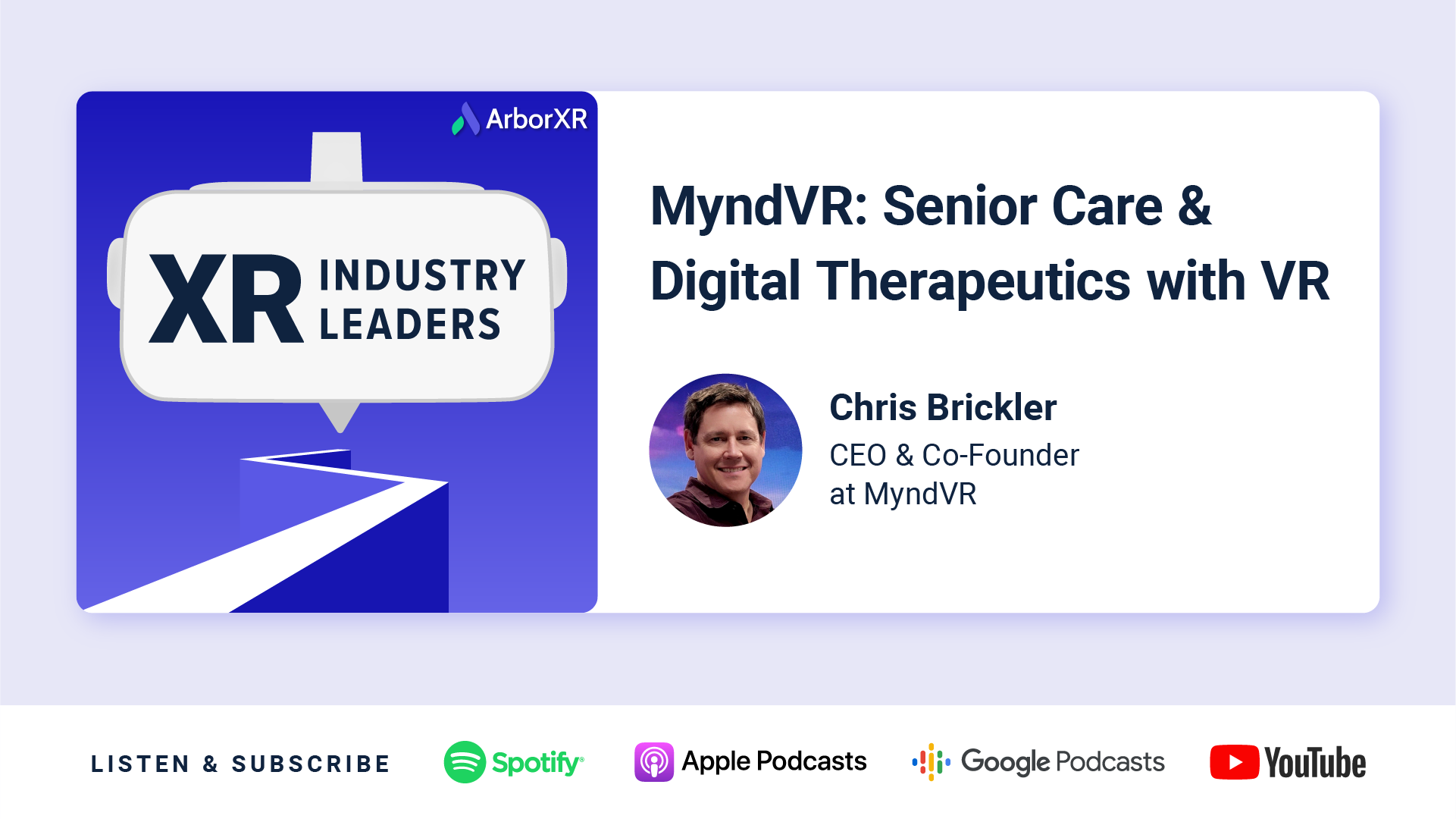
MyndVR: Senior Care and Digital Therapeutics with VR
Chris Brickler shares how VR therapy improves memories and care for elderly patients, and the challenges of scaling VR across health senior care facilities.
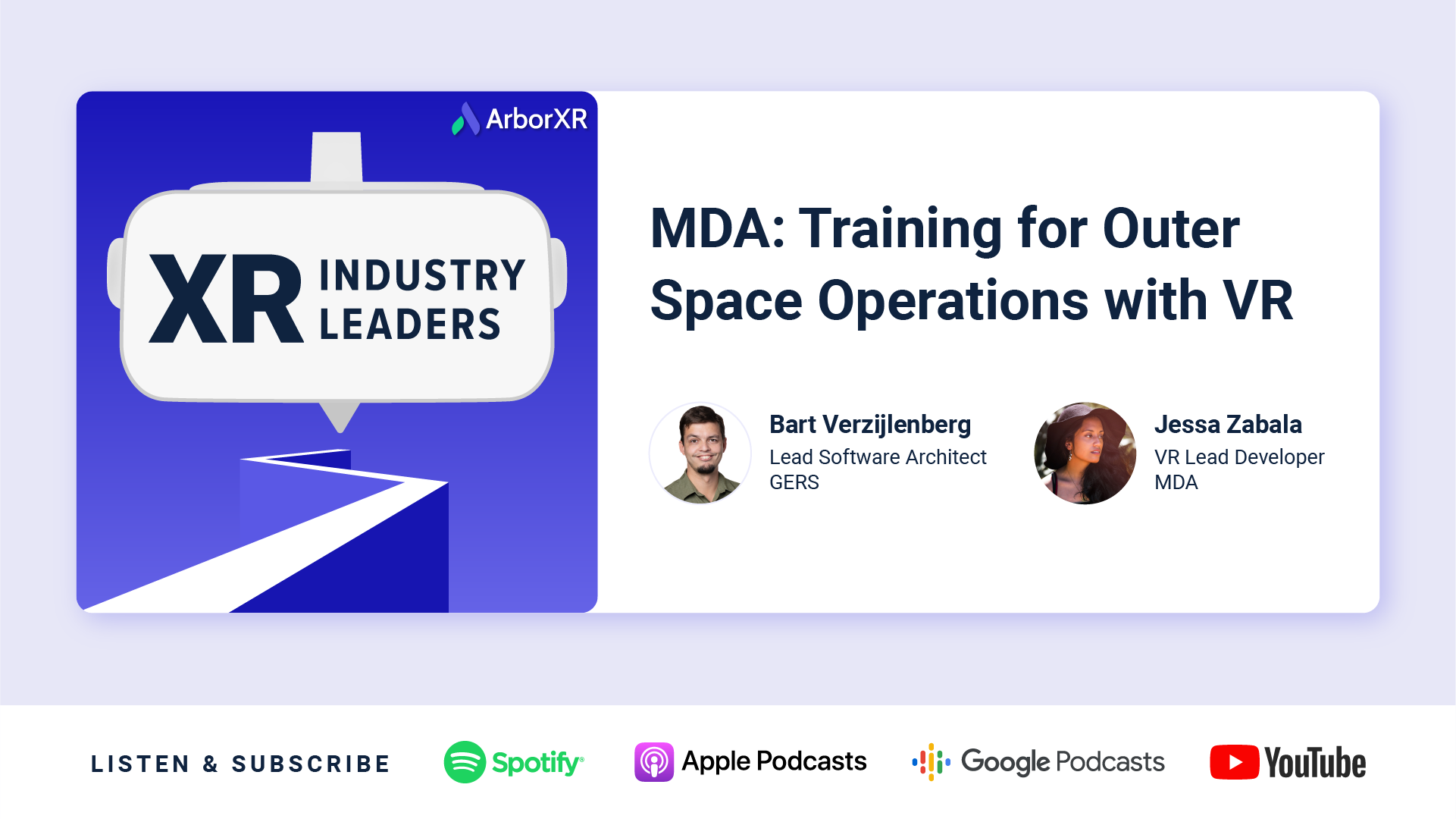
MDA: Training For Outer Space Operations with VR
Discover how MDA leverages VR for astronaut training, mission planning, and onboarding. Gain valuable insights into implementing immersive technologies at scale.

Harvard: Experiential VR Learning in Education
Matt Cook from Harvard joins us to discuss how virtual & augmented reality are redefining higher education through customized immersive experiences.
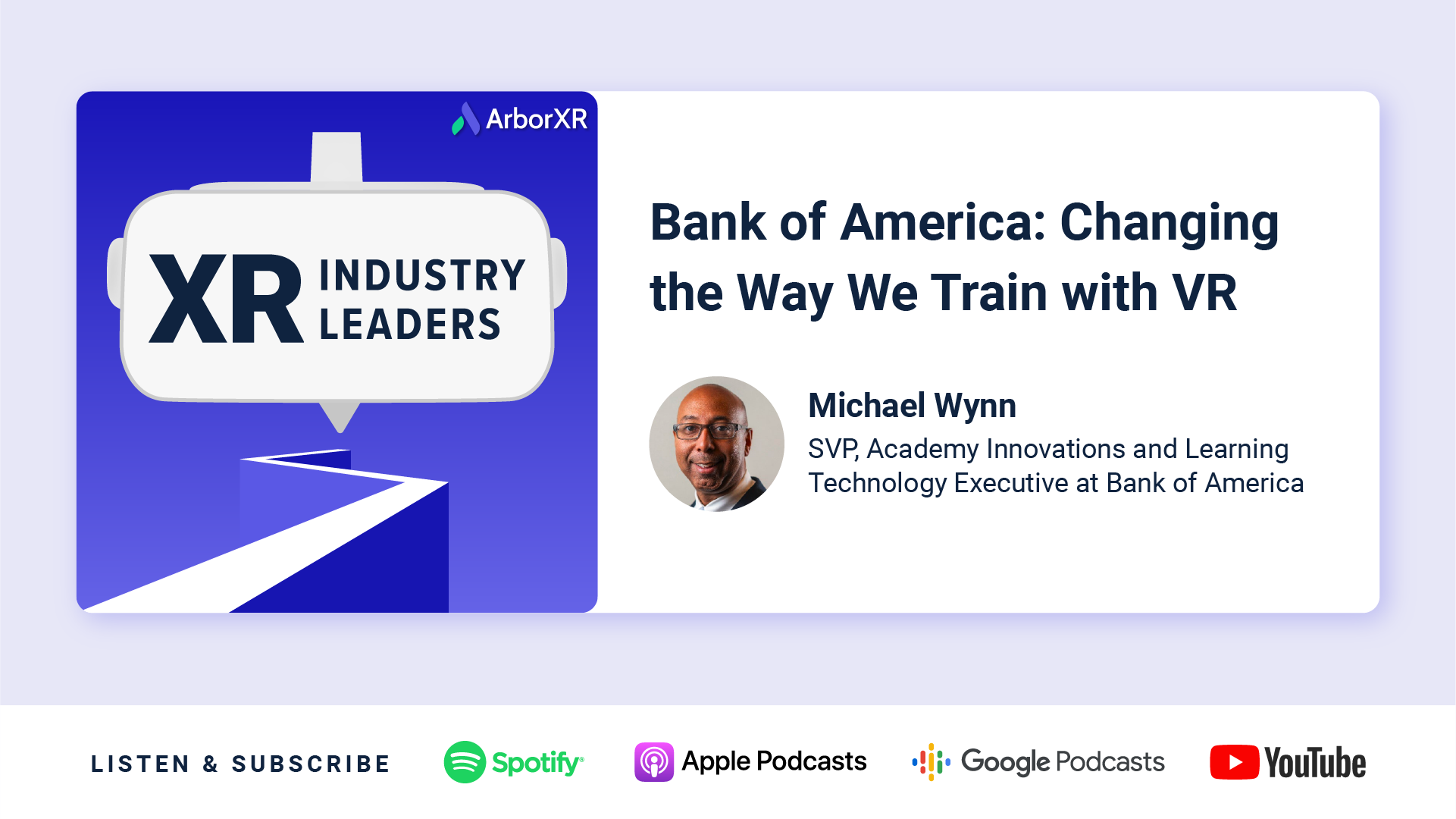
Bank of America: Changing the Way We Train with VR
Explore how Bank of America is revolutionizing training with VR, enhancing employee engagement, overcoming challenges with VR, and redefining corporate education.
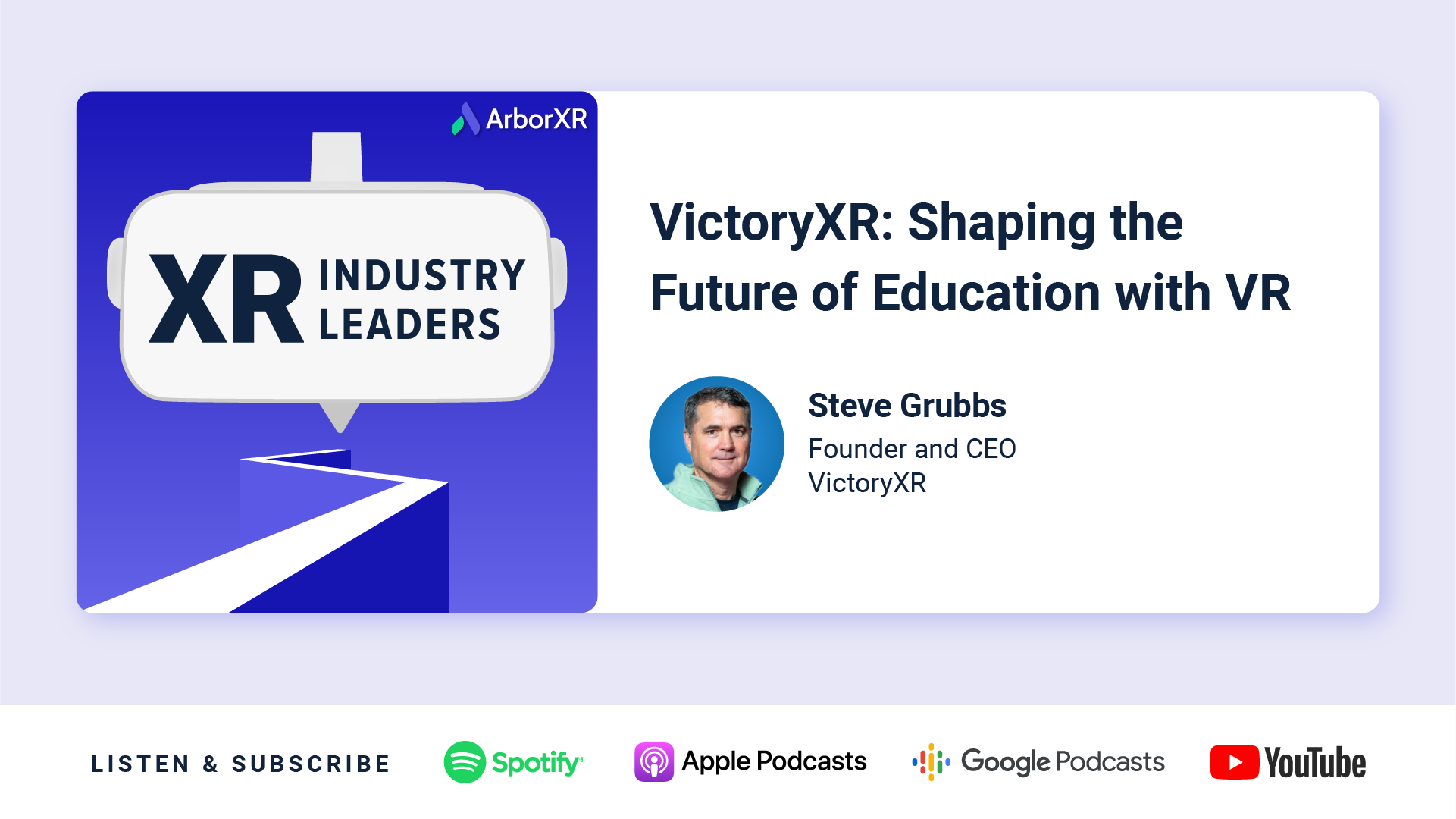
VictoryXR: Shaping the Future of Education with VR
VictoryXR CEO Steve Grubbs discusses creating virtual reality curriculums for education, working closely with Meta, and the future of immersive technology for teachers and students.

VRpatients: Designing Your Own VR Training for Healthcare
Learn how VRpatients creates VR simulations that instructors can customize to give trainees real-life experiences in healthcare.
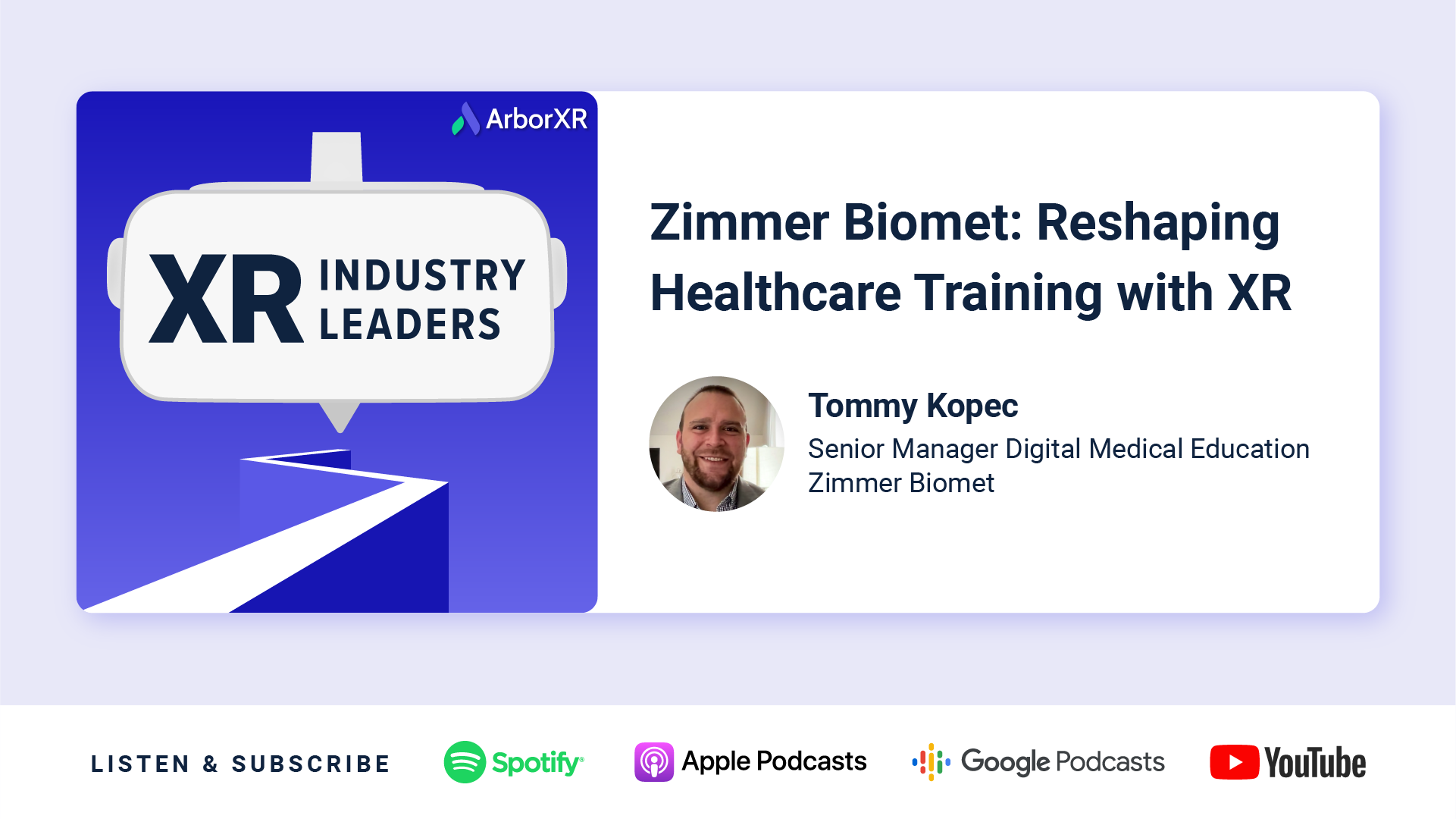
Zimmer Biomet: Reshaping Healthcare Training with AR and VR
If you’re interested in how XR will shape medicine going forward, this is a must-listen episode. Tommy Kopec of Zimmer Biomet provides an insider’s perspective on VR’s transformative potential for surgery, training, and beyond.
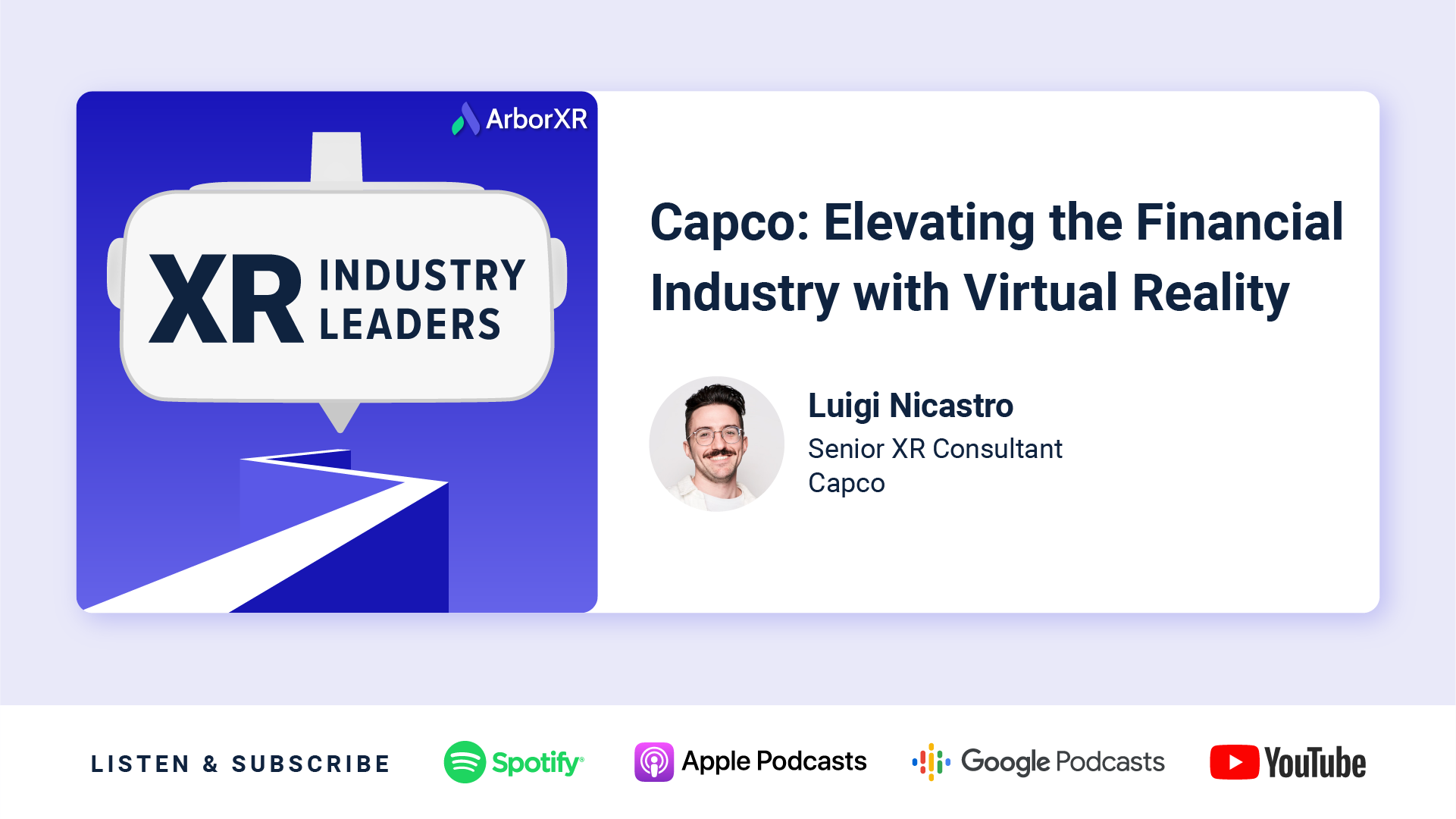
Capco: Elevating the Financial Industry with Virtual Reality
Explore how Capco revolutionizes the financial industry with virtual reality. Discover their success, challenges, and predictions for VR’s impact.

MIT: Exploring Extended Reality in Historic Operas
Discover how MIT uses AR and VR to create immersive experiences for historic operas. We discuss XR in education, challenges and advice for new adopters, and more.

Magic Leap: How Augmented Reality is Elevating Enterprise
Discover how Magic Leap is taking augmented reality to the next level with their enterprise-focused hardware, including real-world statistics and use cases.

Bodyswaps: Innovating Soft Skills Training with Virtual Reality
Discover the future of VR in education with Bodyswaps. Learn how VR elevates soft skills training, and how to implement VR technology effectively.
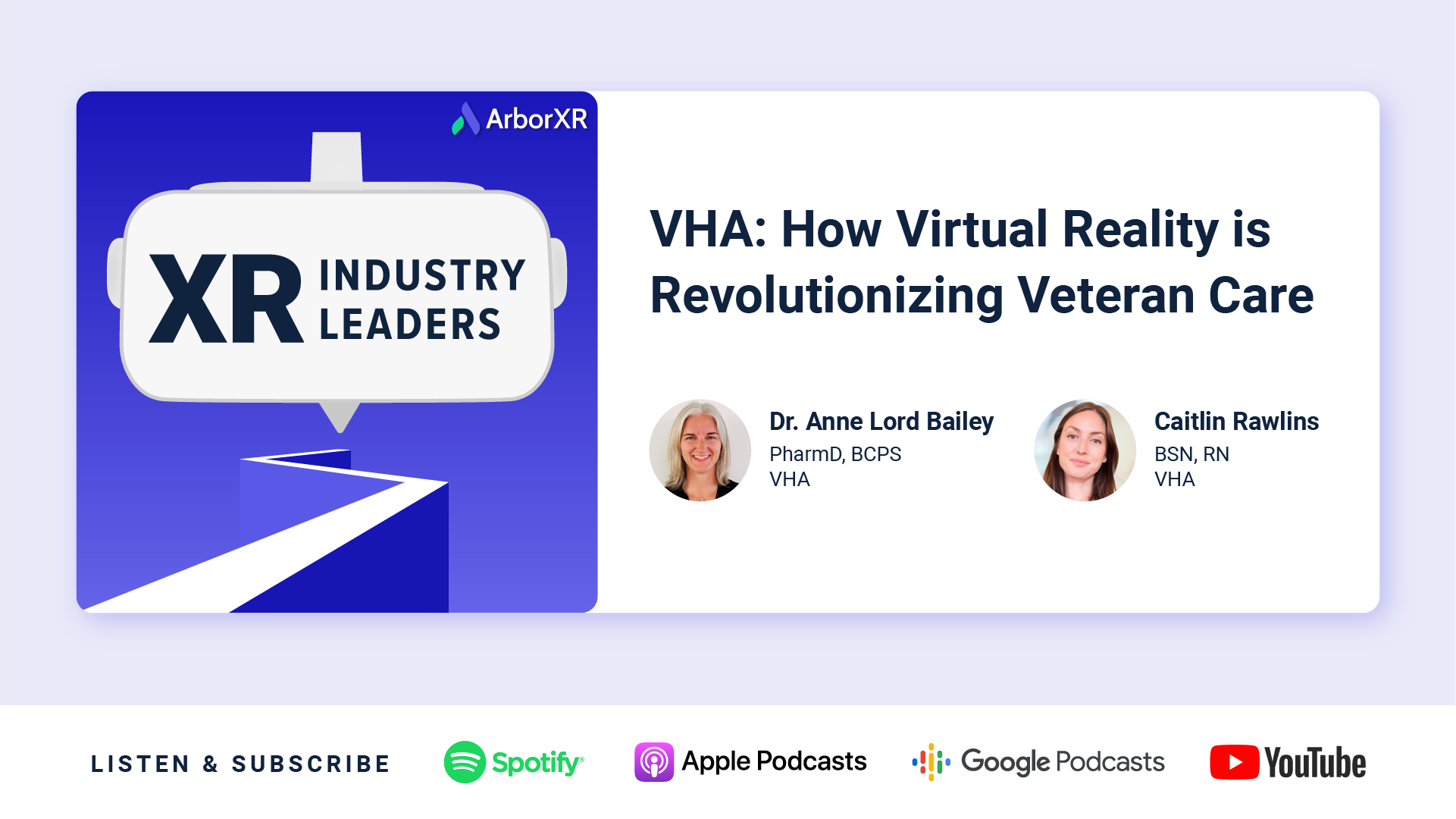
VHA: How Virtual Reality is Revolutionizing Veteran Care
Discover how the VHA is using virtual reality to improve the lives of veterans with pain management, mental health, and overall well-being.
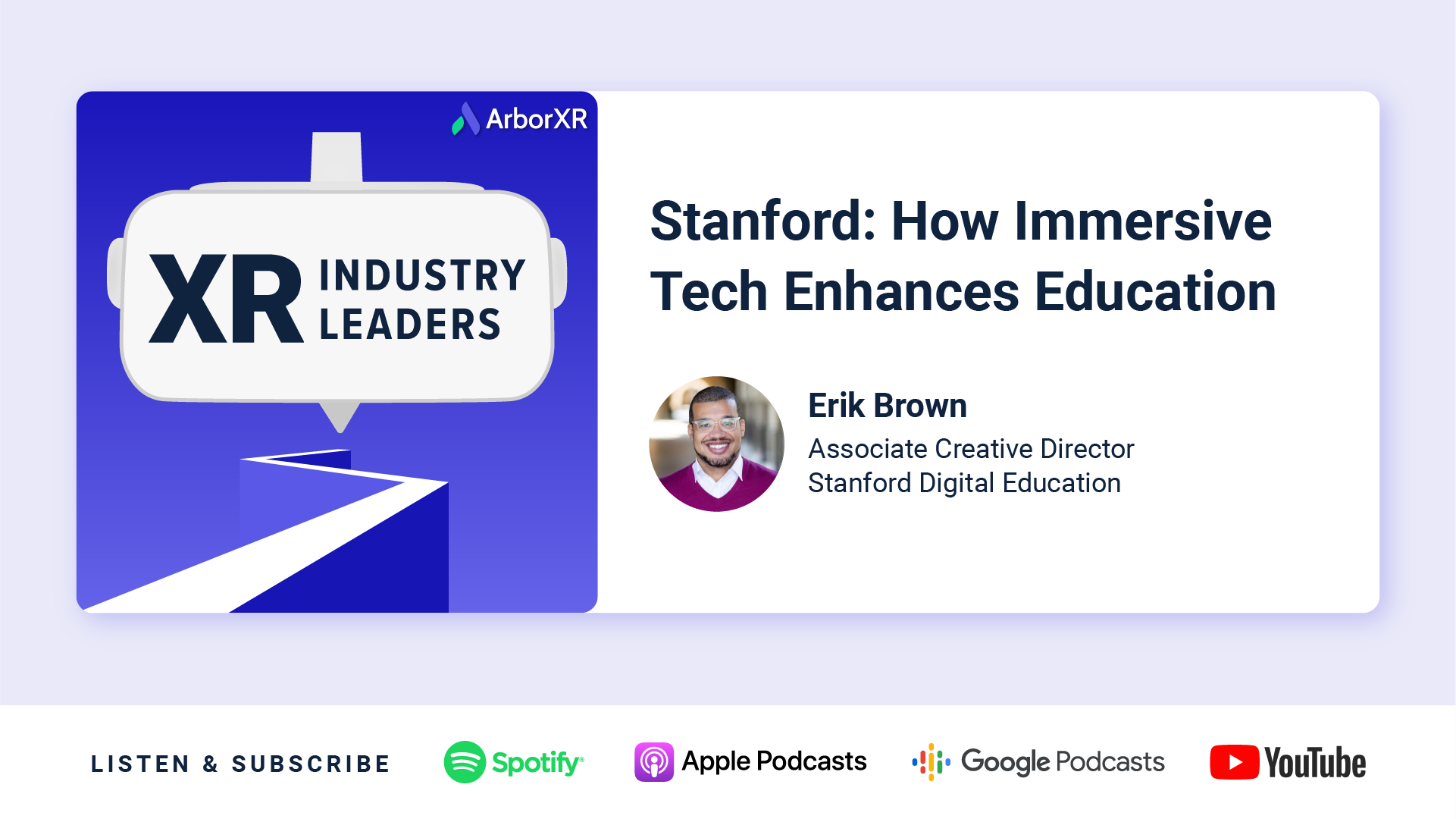
Stanford: How Immersive Technology Enhances Education
Erik Brown discusses how Stanford uses virtual reality for education, empathy in VR, challenges with creating and managing XR content, and more.
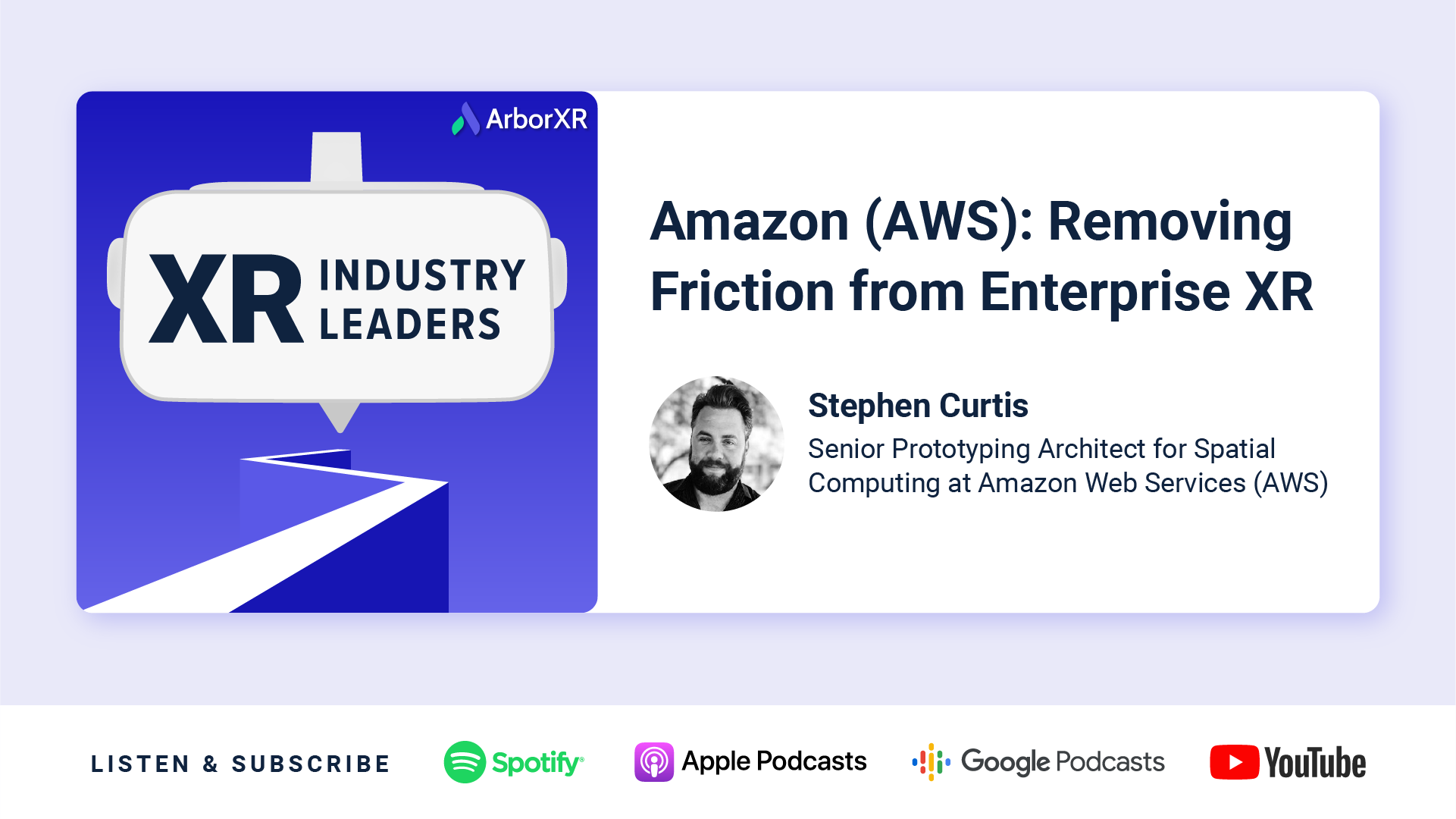
Amazon (AWS): Removing Friction from Enterprise XR
Stephen Curtis from AWS discusses how XR solves enterprise friction, advice for new adopters, XR content authoring, XR device management and more.

WestRock: How XR is Accelerating Manufacturing
XR champion Scott Burkey discusses the impact AR and VR is having on manufacturing, challenges implementing new technology, and advice for using XR in business.

Pfizer: Transforming How We Train with XR
XR leader Nicholas Hockley discusses how XR transformed the way Pfizer trains, challenges with AR/VR content, moving from a pilot program to scale, and more.
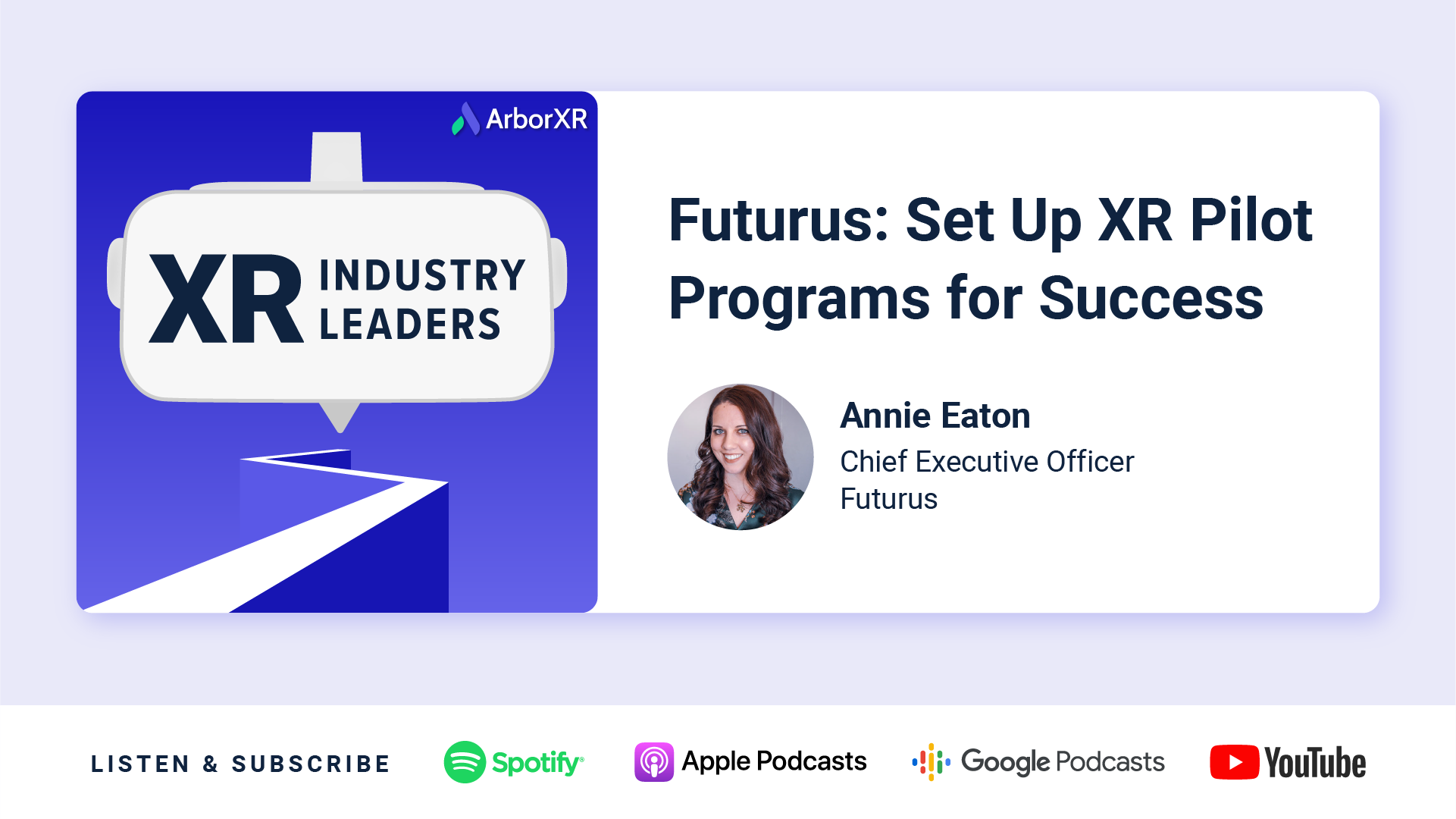
Futurus: Set Up XR Pilot Programs for Success
Futurus CEO Annie Eaton discusses creating AR/VR content, how to set up XR pilot programs for success, challenges in XR, advice for new adopters, and more.
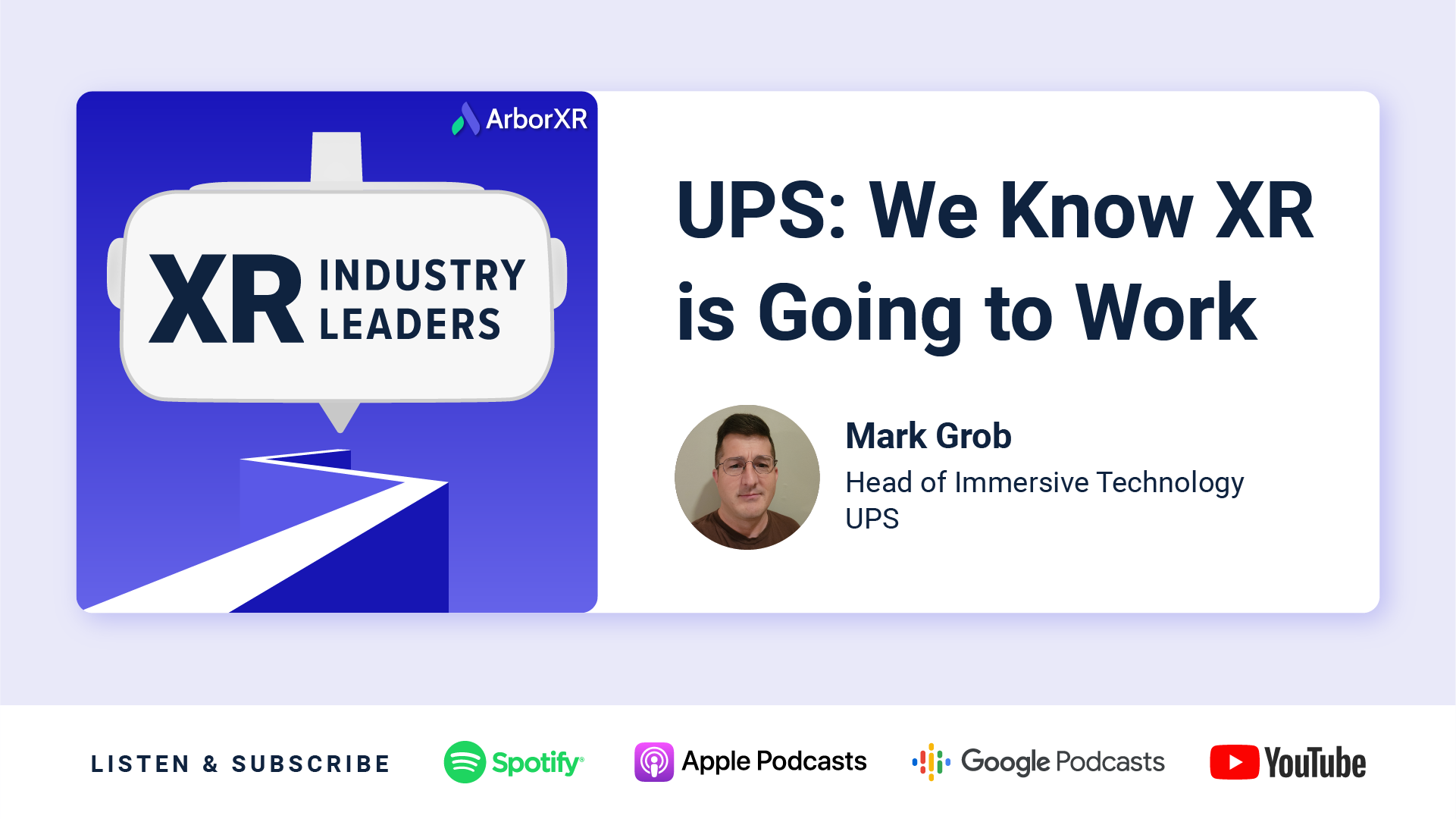
UPS: We Know XR is Going to Work
Learn how UPS built XR training as a practice. We discuss using AR/VR in business, challenges and benefits of XR training, advice for new adopters & more.

INVISTA (Koch Industries): What if We Reimagined Our Entire Training Process?
Learn how XR is transforming INVISTA (Koch). We discuss using AR/VR in business, challenges and benefits of XR training, strategy to scaling XR adoption & more.

Lenovo: Unlocking Enterprise Potential with VR
Dive into the dynamic world of extended reality (XR) with Lenovo’s Vishal Shah and Jason McGuigan as they unravel Lenovo’s new enterprise XR solution: the Lenovo ThinkReality VRX.

PICO: Practical Enterprise Applications in XR at Scale
Explore XR’s future with PICO’s Amir Khorram in XR Industry Leaders. Insightful discussion on VR enterprise solutions, partnerships, and industry adoption.

St. James’s Place: Elevating Soft Skills with VR
Hannah & Josh St. James’s Place discuss using VR to train advisor soft skills, challenges of managing headsets at scale, lessons on user adoption, and content development.

MyndVR: Senior Care and Digital Therapeutics with VR
Chris Brickler shares how VR therapy improves memories and care for elderly patients, and the challenges of scaling VR across health senior care facilities.

MDA: Training For Outer Space Operations with VR
Discover how MDA leverages VR for astronaut training, mission planning, and onboarding. Gain valuable insights into implementing immersive technologies at scale.

Harvard: Experiential VR Learning in Education
Matt Cook from Harvard joins us to discuss how virtual & augmented reality are redefining higher education through customized immersive experiences.

Bank of America: Changing the Way We Train with VR
Explore how Bank of America is revolutionizing training with VR, enhancing employee engagement, overcoming challenges with VR, and redefining corporate education.

VictoryXR: Shaping the Future of Education with VR
VictoryXR CEO Steve Grubbs discusses creating virtual reality curriculums for education, working closely with Meta, and the future of immersive technology for teachers and students.

VRpatients: Designing Your Own VR Training for Healthcare
Learn how VRpatients creates VR simulations that instructors can customize to give trainees real-life experiences in healthcare.

Zimmer Biomet: Reshaping Healthcare Training with AR and VR
If you’re interested in how XR will shape medicine going forward, this is a must-listen episode. Tommy Kopec of Zimmer Biomet provides an insider’s perspective on VR’s transformative potential for surgery, training, and beyond.

Capco: Elevating the Financial Industry with Virtual Reality
Explore how Capco revolutionizes the financial industry with virtual reality. Discover their success, challenges, and predictions for VR’s impact.

MIT: Exploring Extended Reality in Historic Operas
Discover how MIT uses AR and VR to create immersive experiences for historic operas. We discuss XR in education, challenges and advice for new adopters, and more.

Magic Leap: How Augmented Reality is Elevating Enterprise
Discover how Magic Leap is taking augmented reality to the next level with their enterprise-focused hardware, including real-world statistics and use cases.

Bodyswaps: Innovating Soft Skills Training with Virtual Reality
Discover the future of VR in education with Bodyswaps. Learn how VR elevates soft skills training, and how to implement VR technology effectively.

VHA: How Virtual Reality is Revolutionizing Veteran Care
Discover how the VHA is using virtual reality to improve the lives of veterans with pain management, mental health, and overall well-being.

Stanford: How Immersive Technology Enhances Education
Erik Brown discusses how Stanford uses virtual reality for education, empathy in VR, challenges with creating and managing XR content, and more.

Amazon (AWS): Removing Friction from Enterprise XR
Stephen Curtis from AWS discusses how XR solves enterprise friction, advice for new adopters, XR content authoring, XR device management and more.

WestRock: How XR is Accelerating Manufacturing
XR champion Scott Burkey discusses the impact AR and VR is having on manufacturing, challenges implementing new technology, and advice for using XR in business.

Pfizer: Transforming How We Train with XR
XR leader Nicholas Hockley discusses how XR transformed the way Pfizer trains, challenges with AR/VR content, moving from a pilot program to scale, and more.

Futurus: Set Up XR Pilot Programs for Success
Futurus CEO Annie Eaton discusses creating AR/VR content, how to set up XR pilot programs for success, challenges in XR, advice for new adopters, and more.

UPS: We Know XR is Going to Work
Learn how UPS built XR training as a practice. We discuss using AR/VR in business, challenges and benefits of XR training, advice for new adopters & more.

INVISTA (Koch Industries): What if We Reimagined Our Entire Training Process?
Learn how XR is transforming INVISTA (Koch). We discuss using AR/VR in business, challenges and benefits of XR training, strategy to scaling XR adoption & more.
